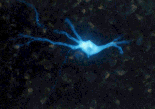| Sponsored by Wake Forest University School of Medicine and National Families in Action | |||
| Glossary - S | |||
| This glossary comes from False Messengers: How Addictive Drugs Change the Brain, by David Friedman, PhD, and Sue Rusche, Harwood Academic Publishers, Amsterdam, The Netherlands, 1999. A
| B | C
| D | E
| F | G
| H | I
|
|
|||
| S Seconal A depressant drug of the barbiturate family that induces sleep. Second messenger A molecule produced inside neurons as a step in the process of communication between cells. The second messenger lets other parts of the cell know that a specific receptor has been activated, thereby completing the message carried by the neurotransmitter that bound to the receptor. Some receptors (e.g., dopamine, opiate) use second messengers. Others (e.g., nicotine, GABA) do not. Secondary reinforcers Formerly neutral stimuli that acquire the ability to produce reward through the learned association with a primary reinforcer. Money and praise are secondary reinforcers. Sensitization An increased response to a drug caused by repeated administration. Sensitization is most commonly seen in some responses to stimulants. Serotonin A neurotransmitter involved in many functions, including mood, appetite, and sensory perception. Short-term effects The acute effects of a drug. The effects felt during and shortly after the time a person is under the influence of (intoxicated by) a drug. Short-term memory Also called "working memory," short-term memory enables us to use information from our senses and from our memory and hold that information in our consciousness long enough to think about it. "Skinner Box" A device that automatically
released food in response to an animal manipulating a specific object
(e.g., pressing a bar). This device allowed scientists to measure behavior
accurately over long periods of time.
|
|
Somatosensory cortex A brain region that processes
information coming from the muscles, joints, and skin. Stimulus Any object or action that penetrates awareness or excites an animal to respond. Stroke The blockade or rupture of a blood vessel in the brain. This prevents oxygen from reaching neurons and may result in their death. Structural proteins Special proteins that form a framework for the cell bodies, dendrites, and axons of neurons. Synapse The site where neurons communicate with each other. A synapse is a small gap that physically separates neurons. Axon terminals of a neuron sending a message (the presynaptic neuron) release neurotransmitters into the synapse. The neurotransmitters diffuse to the other side (the postsynaptic side) where they bind to receptors on the postsynaptic neurons, thereby relaying the message. Synaptic transmission See Neurotransmission. Synthesize To make a chemical from consti parts. Exact copies of drugs found in nature or created in the laboratory are synthesized in laboratories from simpler chemicals. Many substances are also synthesized in cells (e.g., large proteins such as receptors, or smaller ones such as neurotransmitters).
|
|
| Home | For Journalists | For the States | Science Update | Links | Glossary | About |
Last Revision
info@addictionstudies.org

